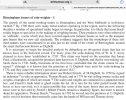I note from Pedro's 1883 Kelly’s info in post #15, that Avery’s had given up (or rented out?) #11 and #12 by that time but retained 12A (wherever that was). #12 was the showroom. Maybe there was no further use for #11 and #12. Perhaps 12A had originally been created by splitting number 12? Wonder why ? For smaller showrooms, smaller products etc ? Less room needed or maybe their sights were set on bigger opportunities such as the Soho Foundry in Smethwick ?
Maybe the new broom of younger family members were starting to take effect as they took overthe reins of the business in 1881 - William Beilby Avery and his brother, Henry J Avery. By 1895 Avery’s bought the Soho Foundry and only the head office remained in Digbeth. Viv.
Maybe the new broom of younger family members were starting to take effect as they took overthe reins of the business in 1881 - William Beilby Avery and his brother, Henry J Avery. By 1895 Avery’s bought the Soho Foundry and only the head office remained in Digbeth. Viv.
Last edited:
























